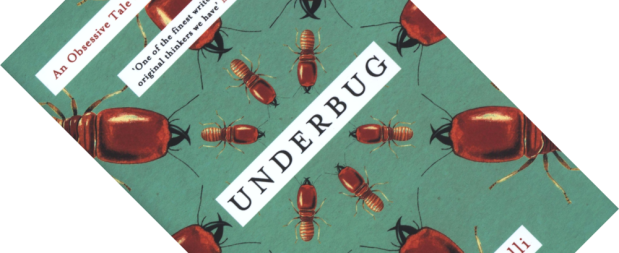When it comes to social insects, ants and bees get all the love. But, if you pardon the pun of the book’s title, termites are a bit of an underbug. While finishing up a previous writing assignment, author Lisa Margonelli got on the trail of the termite sometime in 2008 and spend the next decade obsessing over them. Tailing various scientists and sitting in on their day-to-day work, she here spins a wide-ranging tale about termites and the research they have inspired. The result is a hypnotic book that ranges well beyond this humble insect.

“Underbug: An Obsessive Tale of Termites and Technology“, written by Lisa Margonelli, published in Europe by Oneworld Publications in October 2018 (hardback, 303 pages)
The first person we meet is J. Scott Turner, an eccentric physiologist who has been researching termites in Namibia for several decades. As interested as he is in termite behaviour as the mounds they built, their conversations rapidly touch on bigger topics; termites as a superorganism, swarm intelligence, and emergent properties. As we quickly learn, termite mounds are large farms, with termites growing fungi underground. Are the termites in charge of the fungi, or vice versa? And what about the mounds? Turner’s work using time-lapse photography argues for seeing the mounds themselves as living beings, or at least as part of a superorganism itself (for more on this concept, see The Superorganism: The Beauty, Elegance, and Strangeness of Insect Societies). Furthermore, he favours the idea of cooperation rather than competition being a driving force in evolution (see also SuperCooperators: Beyond the Survival of the Fittest – Why Cooperation, Not Competition, is the Key to Life).
Through Turner, Margonelli gets acquainted with a group of visiting roboticists who are interested in how termites build their mounds. They hope to understand how simple rules give rise to complex, emergent properties (see Complexity: A Guided Tour). If that sounds esoteric, there would be very real-world applications to this, either virtually as inroads into building artificial intelligence, but also in the real world in the form of autonomous swarms of robots that could construct buildings, either here or in a galaxy far, far away.
“roboticists are interested in how termites build their mounds […] in the future, autonomous swarms of robots could construct buildings, either here or in a galaxy far, far away.”
Similarly cutting-edge is the work of the genomics researchers she meets. With advances in technology, genomics is racking up data faster than it can be analysed, or even comprehended. No longer are we sequencing genetic material from single species, but also from all the microbes living in their guts for example. Hence the talk of metagenomics. Since termites are capable or digesting wood fibres, there is intense interest in unravelling the biochemical details of their digestion. It could open the door to a new breakthrough in biofuels and wean humanity off fossil fuels.
On the other side of the spectrum are the researchers who look at landscape-scale effects of termites. Mathematical principles can explain how mounds and vegetation interact to form regular patterns in the landscape. The incredible quantities of dirt and water that termites move around make them ecosystem engineers, capable of providing conditions for other plants and animals to thrive. And research in Australia has shown their role in restoring former mining sites.
If you are not all that familiar with social insects, complexity, or metagenomics – neither was Margonelli. Her ringside seat as a spectator makes her as much as an outsider as the reader, and she makes no secret of the fact that some of the technical details her interviewees discuss go over her head. The good thing is that she manages to close that gap in understanding – I cannot quite put my finger on what it is, but there is something utterly hypnotic about her writing that drew me right in.
“Occasionally, termites turn into larger-than-life metaphors, and Margonelli teeters on the brink of existential rabbit holes.”
Though you will learn a lot about termites, space is also given to the people behind all this research – their motivations, their quirks. Since this book had a long gestation period, Margonelli revisits certain researchers over the years as they advance through their academic careers and make fascinating new discoveries.
Equally, termites function as a springboard for tangents. A few chapters spin away from the roboticists to talk about the ethics of drone warfare, the involvement of the military in scientific innovation, or the potential dangers of technological progress. Occasionally, termites turn into larger-than-life metaphors, and Margonelli teeters on the brink of existential rabbit holes before pulling back. In the hands of other writers this might have turned into a hopeless mess, but Margonelli mostly manages to loop it all back to the termites. And her excellent writing makes these sections no less fascinating.
Like her obsessive, decade-long immersion in the world of the termites, I gulped this book down in one long sitting, unable to let go of it. Margonelli provides a unique peek into the otherworldly world of the termite colony, and all the research it inspires.
Disclosure: The publisher provided a review copy of this book. The opinion expressed here is my own, however.

, hardback or ebook
Other recommended books mentioned in this review:




3 comments